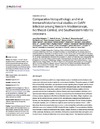Identificador persistente para citar o vincular este elemento:
https://accedacris.ulpgc.es/jspui/handle/10553/69847
| Título: | Comparative histopathologic and viral immunohistochemical studies on CeMV infection among Western Mediterranean, Northeast-Central, and Southwestern Atlantic cetaceans | Autores/as: | Diaz Delgado, Josue Groch, Kátia R. Sierra Pulpillo, Eva María Sacchini, Simona Succa, Daniele Quesada Canales, Ildefonso Óscar Arbelo Hernández, Manuel Antonio Fernández Rodríguez, Antonio Jesús Santos, Elitieri Ikeda, Joana Carvalho, Rafael Azevedo, Alexandre F. Lailson-Brito, Jose Flach, Leonardo Ressio, Rodrigo Kanamura, Cristina T. Sansone, Marcelo Favero, Cíntia Porter, Brian F. Centelleghe, Cinzia Mazzariol, Sandro Renzo, Ludovica Di Francesco, Gabriella Di Guardo, Giovanni Di Catão-Dias, José Luiz |
Clasificación UNESCO: | 310907 Patología 3105 Peces y fauna silvestre |
Palabras clave: | Dolphins Cerebrum Central nervous system Lymph nodes Spleen, et al. |
Fecha de publicación: | 2019 | Publicación seriada: | PLoS ONE | Resumen: | This is an open access article distributed under the terms of the Creative Commons Attribution License, which permits unrestricted use, distribution, and reproduction in any medium, provided the original author and source are credited. Cetacean morbillivirus (CeMV) is a major natural cause of morbidity and mortality in cetaceans worldwide and results in epidemic and endemic fatalities. The pathogenesis of CeMV has not been fully elucidated, and questions remain regarding tissue tropism and the mechanisms of immunosuppression. We compared the histopathologic and viral immunohistochemical features in molecularly confirmed CeMV-infected Guiana dolphins (Sotalia guianensis) from the Southwestern Atlantic (Brazil) and striped dolphins (Stenella coeruleoalba) and bottlenose dolphins (Tursiops truncatus) from the Northeast-Central Atlantic (Canary Islands, Spain) and the Western Mediterranean Sea (Italy). Major emphasis was placed on the central nervous system (CNS), including neuroanatomical distribution of lesions, and the lymphoid system and lung were also examined. Eleven Guiana dolphins, 13 striped dolphins, and 3 bottlenose dolphins were selected by defined criteria. CeMV infections showed a remarkable neurotropism in striped dolphins and bottlenose dolphins, while this was a rare feature in CeMV-infected Guiana dolphins. Neuroanatomical distribution of lesions in dolphins stranded in the Canary Islands revealed a consistent involvement of the cerebrum, thalamus, and cerebellum, followed by caudal brainstem and spinal cord. In most cases, Guiana dolphins had more severe lung lesions. The lymphoid system was involved in all three species, with consistent lymphoid depletion. Multinucleate giant cells/ syncytia and characteristic viral inclusion bodies were variably observed in these organs. Overall, there was widespread lymphohistiocytic, epithelial, and neuronal/neuroglial viral antigen immunolabeling with some individual, host species, and CeMV strain differences. Preexisting and opportunistic infections were common, particularly endoparasitism, followed by bacterial, fungal, and viral infections. These results contribute to understanding CeMV infections in susceptible cetacean hosts in relation to factors such as CeMV strains and geographic locations, thereby establishing the basis for future neuro- and immunopathological comparative investigations. | URI: | https://accedacris.ulpgc.es/handle/10553/69847 | ISSN: | 1932-6203 | DOI: | 10.1371/journal.pone.0213363 | Fuente: | PLoS ONE [ISSN 1932-6203], v. 14 (3), e0213363. |
| Colección: | Artículos |
Citas SCOPUSTM
24
actualizado el 08-jun-2025
Citas de WEB OF SCIENCETM
Citations
21
actualizado el 08-jun-2025
Visitas
184
actualizado el 17-may-2025
Descargas
122
actualizado el 17-may-2025
Google ScholarTM
Verifica
Altmetric
Comparte
Exporta metadatos
Los elementos en ULPGC accedaCRIS están protegidos por derechos de autor con todos los derechos reservados, a menos que se indique lo contrario.
